This post may contain affiliate links. See my disclosure policy.
Vibrant Buddha Bowl Recipe filled with roasted cauliflower, chickpeas, fresh greens, and fiber-filled quinoa drizzled with a Creamy Peanut Butter Coconut Milk Dressing. Learn how to make your very own Buddha Bowl and enjoy this delicious vegan and gluten-free power bowl for a healthy lunch or dinner.
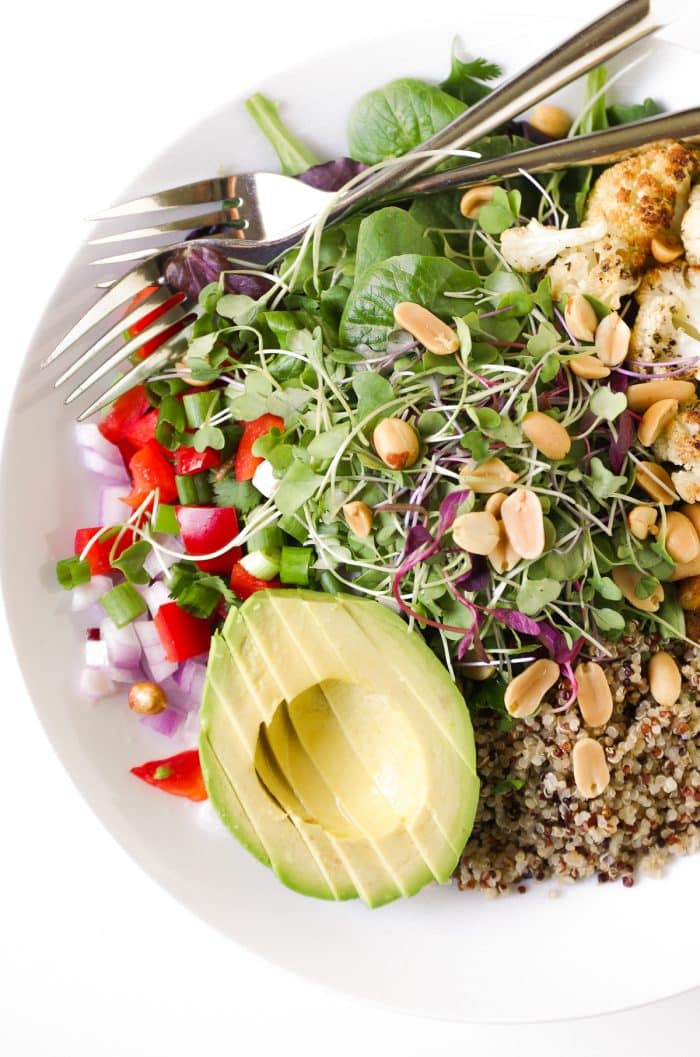
What is a Buddha Bowl?
We’ve all seen one somewhere, but what really makes a Buddha bowl a…Buddha bowl?
Similar to Nourish Bowls (non-vegetarian) and Poké Bowls (Hawaiian bowls filled with raw fish), Buddha bowls are a one-dish vegetarian meal traditionally served in a large bowl or high-rimmed plate. Most Buddha bowls typically contain small portions of several key foods – usually a grain, vegetable, protein, fat, and dressing.
Why is it called Buddha Bowl?
So where exactly did the name “Buddha Bowl” come from? The truth is that there are several possible explanations,
The first, most popular explanation, is that the overstuffed bowl resembles the belly of Budai, a 10th-century Chinese monk who resembles and is often confused with Buddha. A second idea suggests that the Buddha bowl, a nutritious and balanced meal, represents the Buddhist belief of balance and harmony. A final idea draws from the story that each morning Buddha would carry a bowl with him through the town picking up and collecting small bits of food donated from local townspeople.
You may also find Buddha bowls called power bowls, hippie bowls, sunshine bowls, or macro bowls.
Is a Buddha Bowl hot or cold?
Buddha bowls come in all colors, textures, and varieties and that’s part of what makes them so delicious. People often wonder if Buddha bowls should be enjoyed warm or cold – the truth is that they are fantastic any way like them!
For me personally, I love to have a mix of warm and cold. In the case of this cauliflower and quinoa Buddha bowl recipe, I find that it tastes best with roasted cauliflower just out of the oven. Everything else can be prepared ahead of time and served cold, unless, of course, you prefer to reheat the chickpeas and quinoa.
What goes in a Buddha Bowl?
There are five main parts that go into these insta-worthy beauty bowls. Don’t feel pressured to add all five, but for ultimate color and flavor, try to pick one item from each category.
- Grains – Quinoa, barley, brown rice, freekeh (my personal favorite), whole-wheat couscous, and bulgur are all popular options and all considered whole grains. These whole grains contain more fiber and nutrients which help you stay full, longer. Certain whole grains cook quickly, while others take more time. If you’re short on time check the freezer section at your market (hello! Trader Joe’s) for pre-cooked frozen brown rice and quinoa.
- Vegetables – I like to add both fresh vegetables (lettuce, microgreens, tomatoes, bell pepper, onions) and roasted veggies (Butternut Squash, Roasted Brussels Sprouts, Roasted Acorn Squash, Roasted Asparagus, broccolini, baked sweet potatoes, etc). This is a fantastic opportunity to clean-out all those refrigerator scraps or leftover vegetable odds-and-ends.
- Plant-based protein – Depending on your definition of a “Buddha bowl” yours may or may not be meat-free. I like to serve mine without meat, but that doesn’t mean there isn’t any protein. Load yours up with plant-based protein options like chickpeas or tofu.
- Healthy fat – You will often find Buddha bowls topped with some kind of “healthy” fat. This includes sliced avocado or whole, unsalted nuts like almonds and cashews, chia seeds, and flax seeds.
- Dressing – No store-bought dressing here (if you can help it). Homemade anything is better than what you’ll find at the store. Simple vinaigrettes to creamy tahini, miso dressing to this AH-MAZ-ING peanut butter coconut dressing.
- Bonus number 6 – But wait, there’s more! Yes, really. I always encourage dried fruits like cranberries or raisins or fresh fruit like berries or grapes.
Build your own Buddha Bowl
Here’s what you’ll find in this cauliflower Buddha bowl drizzled with peanut butter coconut milk dressing:
- Grain – Quinoa
- Vegetable – Cauliflower, mixed greens, microgreens, diced bell pepper, red onion, and green onion
- Protein – Chickpeas
- Healthy Fat – Avocado
- Dressing – Peanut Butter Coconut Milk Dressing
Now that we know what’s needed to make a Buddha bowl, and what’s being added to this delicious recipe, let’s make it!
1. Roast the chickpeas
Preheat oven to 400°F. and line a large rimmed baking sheet with parchment paper. As the oven warms, drain and rinse your chickpeas and transfer to a clean towel or stack of 2-3 paper towels. Gently rub the chickpeas dry using a dry paper towel or dishtowel. The skins will start to peel off- that’s ok.
Transfer chickpeas to a large mixing bowl and gently toss with the olive oil, garlic powder, cayenne powder, chili powder, salt, and pepper. Transfer chickpeas to the prepared baking sheet and spread in a single layer. Bake for approximately 25-35 minutes. Remove from the oven and set aside.
2. Roast the cauliflower
Wash, dry, and remove all greens from the cauliflower. Next, chop the cauliflower into 1 to 2-inch florets. Line a second large baking sheet with parchment paper or aluminum foil.
In a large mixing bowl or directly on the baking sheet toss the cauliflower florets with olive oil, salt, and pepper. Arrange cauliflower florets in a single layer. Transfer baking sheet to the oven and bake for approximately 25-35 minutes, or until fully cooked and just starting to brown at the edges (for extra crispy edges, set oven to broil and roast for 1-2 minutes at the end of cooking). Remove roasted chickpeas from the oven and set aside.
3. Make the dressing
If preferred, substitute the peanut butter with almond butter or cashew butter.
4. Assemble your Buddha Bowl
Cook quinoa according to package instructions. Chop the red bell pepper, red onion, and green onions and set aside in a small bowl. Mix well to combine.
To serve, add quinoa to a large bowl or plate with high sides. Top with roasted chickpeas, cauliflower, diced vegetables, fresh greens, peanuts, and avocado. Just before serving drizzle with your homemade peanut butter coconut milk dressing. Garnish with additional peanuts and chopped cilantro, if desired.
More bowl recipes,
If you try cooking this Buddha Bowl Recipe, please leave me a comment and let me know! I always love to hear your thoughts.

Veggie Power Bowl Recipe with Peanut Butter Coconut Milk Dressing
Ingredients
For the Chickpeas:
- 1 (15 oz) can chickpeas, drained, rinsed and pat dry with a paper towel
- 2 teaspoon olive oil
- ½ teaspoon garlic powder
- ½ teaspoon cayenne powder
- ½ teaspoon chili powder
- salt + pepper, to taste
For the Cauliflower:
- 1 large cauliflower, cut into bite-size florets
- 1 tablespoon olive oil
- salt + pepper, to taste
For the Dressing:
- ½ cup coconut milk
- 2 cloves garlic, minced
- 1 teaspoon curry powder
- 1 tablespoon Sriracha
- 4 tablespoon creamy peanut butter
- salt + pepper, to taste
- 1.5 tablespoon apple cider vinegar
For the Salad:
- 1 cup quinoa, cooked according to package instructions
- 1 red bell pepper, seeded and diced
- ½ red onion, diced
- ½ cup green onions, chopped
- Your favorite greens and/or micro-greens
- ¼ cup peanuts
- 1 large avocado, peeled, pitted and sliced
Instructions
For the chickpeas
- Prepare the chickpeas - Preheat oven to 400°F. and line a large rimmed baking sheet with parchment paper. Set aside. As the oven warms, drain and rinse your chickpeas and transfer to a clean towel or stack of 2-3 paper towels. Using another dry paper towel or dishtowel to gently rub the chickpeas dry. The skins will start to peel off- that's ok.
- Toss in spices and bake - Transfer chickpeas to a large mixing bowl and gently toss with the olive oil, garlic powder, cayenne powder, chili powder, salt, and pepper. Transfer chickpeas to the prepared baking sheet in a single layer and bake for approximately 25-35 minutes.
- Remove - Remove roasted chickpeas from the oven and set aside.
For the cauliflower
- Prepare the cauliflower - Wash, dry, and remove all greens from the cauliflower. Next, chop the cauliflower into 1 to 2-inch florets. Meanwhile, preheat oven to 400°F and line a large baking sheet with parchment paper or aluminum foil.
- Toss cauliflower in olive oil and bake - In a large mixing bowl or directly on the baking sheet toss the cauliflower florets with olive oil, salt, and pepper. Arrange cauliflower florets in a single layer. Transfer baking sheet to the oven and bake for approximately 25-35 minutes, or until fully cooked and just starting to brown at the edges. Optional- for extra crispy edges, set oven to broil and roast for 1-2 minutes at the end of cooking.
- Remove - Remove roasted chickpeas from the oven and set aside.
For the dressing
- Add all ingredients for the dressing to the bowl of a small food processor and process until smooth. Or, whisk by hand / shake everything together in a jar secured with a fitted lid. Season to taste.
Assemble
- For the Salad- Cook quinoa according to package instructions. Chop the red bell pepper, red onion, and green onions and set aside in a small bowl. Toss to combine.
- Build your veggie bowls. Just before serving drizzle with your homemade peanut butter coconut milk dressing. Garnish with additional peanuts and chopped cilantro, if desired.
Notes
Nutrition
Nutrition information is automatically calculated, so should only be used as an approximation.

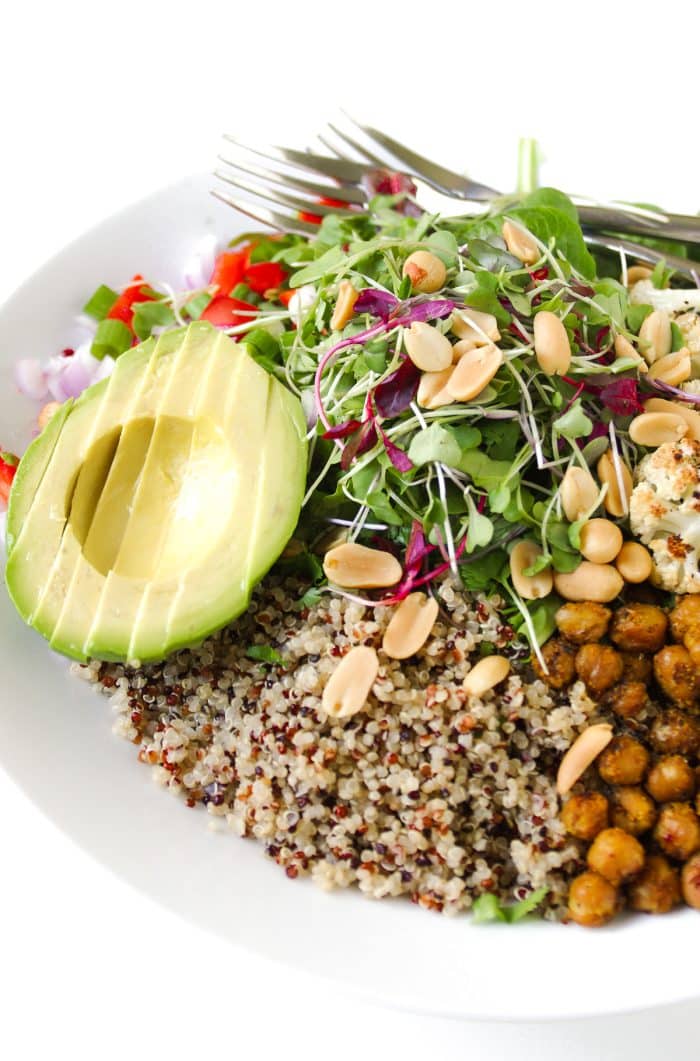
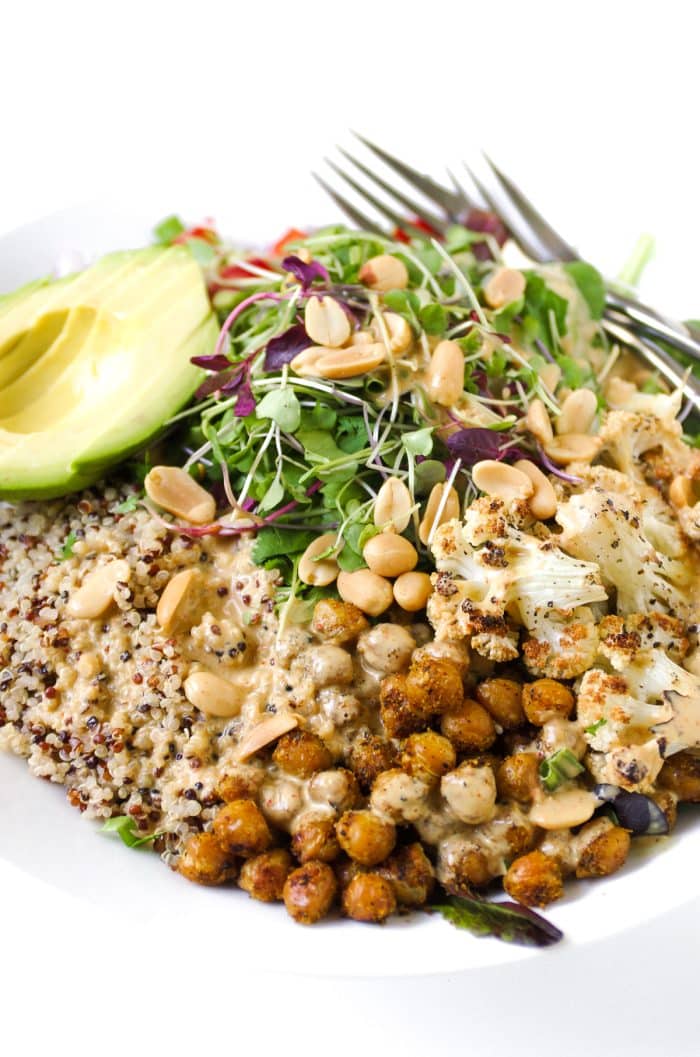
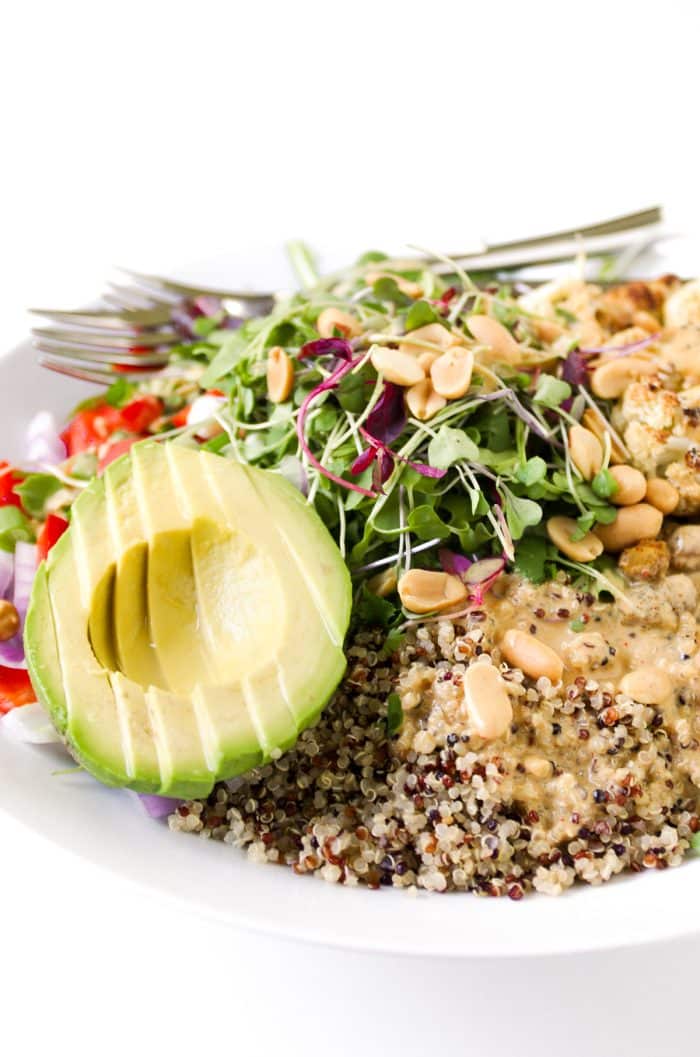
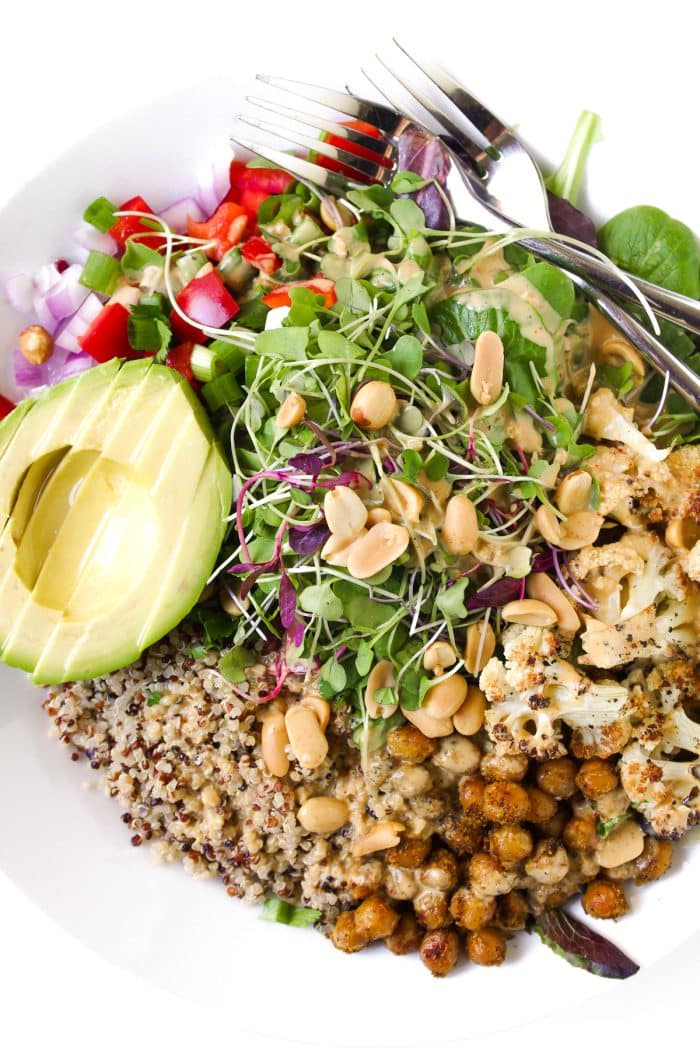

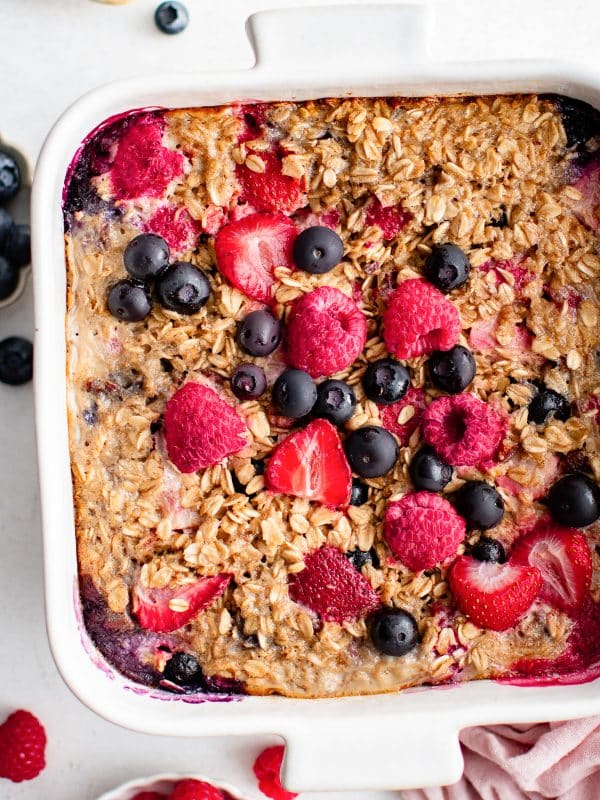


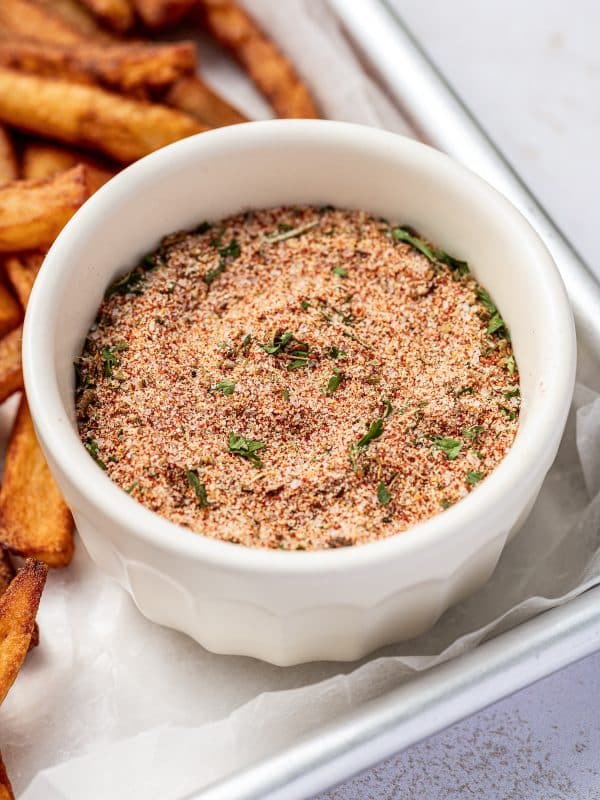








I made the dressing for another bowl and it was fabulous! I even froze some for future use.
Thanks for the fabulous feedback Vicki 🙂